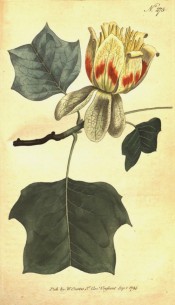Liriodendron tulipifera L.
Large deciduous tree with alternate, three-lobed leaves and large, solitary, very fragranr green, yellow and orange flowers in summer. To 30m. [RHSD, Hortus, Hilliers’].
Horticultural & Botanical History
‘The Tulip-tree is a native of most parts of North-America, Marshall describes it as often growing to the size of a very large tree, 70 or 80 feet in height, and above 4 feet in diameter; he mentions two varieties, one with yellow and the other with white wood; that with yellow wood is soft and brittle, much used for boards, heels of shoes, also turned into bowls, trenchers, &. the white is heavy, tough, and hard, and is sawed into joists, boards, &. for building. Ray informs us in his Hist. Pl. that this tree was cultivated here by Bishop Compton, in 1688: and from Miller we learn, that the first tree of the kind which flowered in this country, was in the gardens of the Earl of Peterborough, at Parsons-Green, near Fulham; in Mr. Ord’s garden, at Walham-Green, there is, among other choice old trees, a very fine tulip-tree, which is every year covered with blossoms, and which afforded us the specimen here figured. It flowers in June and July, rarely ripens its seeds with us, though it does readily in America.’ [BM t.275/1794]. Introduced to Britain in 1663. [JD].
‘Liriodendron Tulipifera is found from Rhode Island to southwestern Vermont and west to the southern shores of Lake Michigan, and extends south to northern Florida, southern Alabama and Mississippi. It occurs west of the Mississippi River only in southeastern Missouri and the adjacent parts of Arkansas. It prefers deep rich and rather moist soil on the intervales of streams or on mountain slopes, and is most abundant and reaches its greatest development in the valleys of the rivers flowing into the Ohio, and on the lower slopes of the high mountains of North Carolina and Tennessee. The Tulip-tree, although widely distributed, is nowhere common enough to become the characteristic feature of the forest, and even in regions where the soil and climatic conditions are most favorable to it, more than four or five large specimens are seldom found growing on a single acre of ground.
John Tradescant, who visited America about the middle of the seventeenth century, sent several plants from this country to England, and the Tulip-tree was perhaps among them. It appeared in several English gardens soon after Tradescant’s return from America, and was cultivated by Bishop Compton at Fulham as early as 1688, a year later than the date of the publication of Hermann’s description, which was drawn up from a tree in the Leyden garden. Few permanent varieties of Liriodendron have been developed in cultivation, although for more than a hundred years it has been a favorite ornamental tree in America and Europe. A form with nearly entire leaves, and others with the leaves marked with yellow or silver blotches, are known in gardens; and a seedling with strictly fastigiate branches appeared a few years ago in the nursery establishment of Simon-Louis at Metz in Germany, where it has been propagated.’ [Sargent – The Silva of North America vol.1, p.19/1891].
History at Camden Park
Desideratum to Loddiges’ Nursery, 6th January 1845. [MP A2933-2, p.28]. It is marked with a ‘c’, denoting grown at Camden, in an 1836 Loddiges’ catalogue held at Camden Park. This indicates that it was grown at Camden before 1845 but probably lost.
Notes
Published Mar 24, 2010 - 12:10 PM | Last updated Mar 24, 2010 - 01:43 PM
| Family | Magnoliaceae |
|---|---|
| Category | |
| Region of origin | North America |
| Synonyms |
|
| Common Name | Tulip tree, White wood, Yellow poplar |
| Name in the Camden Park Record |
Liriodendron tulipifera |
| Confidence level | high |


